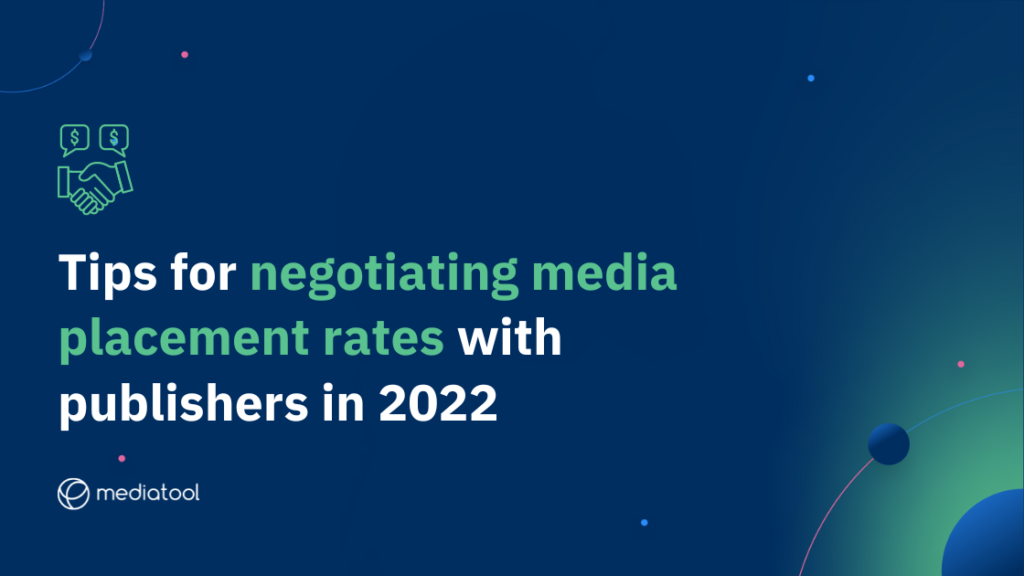Once the media plan is established, it’s time for media buyers to pull up their contact list and test the robustness of that strategy and budgets. And that’s where the tricky business begins. Media buying is all about relationships and negotiations. Mind you, it’s not as exhilarating as watching a stockbroker on a trading floor, but it requires steel nerves and a devilishly strategic approach.
If you’re keen on learning about media negotiation, we’ve wrapped up the key insights for you right here!
Don’t go by the rate card
Everything is negotiable. When it comes to media buying and media negotiation, it’s best to think of the rate card as a conversation starter. Like a master haggler at a market in Marrakech, you should go into the negotiations with a good understanding of the market’s going rate, plus some leverage.
Needless to say, price is only one of the many aspects to negotiate – position, timing, value-adds, commitment, and multiple other factors come into play. Factors that you can use to your advantage to get the best bargain – so let’s see what else you must cover.
Negotiate research
Most media outlets conduct regular readership, viewership, or listenership research campaigns to find out what their audience is craving. They also collect various data points on their followers, which is a gold mine of information in this day and age. Assuming you’re selecting a particular media channel because they already found your target audience, negotiating access to insights or coverage in these research campaigns could be immensely beneficial to your future media plans and ad campaigns.
Consider ad position/timing
To get the better end of the bargain, you must know exactly what you want. Whether it’s media placement in a magazine, a promo soundbite on a podcast or a web banner on a popular blog, you’ll find that certain positions and time slots are much more effective than others. Research media consumption behaviours and habits to be able to decipher the good from the bad and go into the negotiations with a clear idea of what will work best for your brand. If you can’t get the media sales rep to budge on the price, you can press them on a better placement for your advertisement.
Speak volume
It’s a basic negotiations tactic in sales, but it still works like a charm. If you’re planning to place multiple ads with a selected media outlet, be sure to negotiate a bulk price and potentially lower your total ad spend. From the media’s perspective, locking in a long-term deal is the safest way to build predictable revenue and reach or even surpass their yearly targets. Knowing this gives you the leverage to ask them to reciprocate in the form of lower prices. It’s a win-win for both parties!
Negotiate packages
The outbreak of COVID-19 had a dire effect on the overall ad spend on traditional media. With advertisers pouring their budgets into digital channels, the new normal in media buying is starting to set in. That’s bad news for traditional media outlets, but potentially excellent news for seasoned negotiators. Instead of approaching a single media outlet, media buyers should shift their thinking and focus on negotiating package deals with media groups. When relevant, selecting media vehicles that belong to one media group (instead of scattering your budget across multiple outlets) gives you more negotiating power to build your own well-rounded package.
Consider flexible advertising options
In media buying, both parties are interested in building a healthy, long-term relationship. Sometimes this means setting aside aggressive negotiation tactics and looking for more creative solutions. One of the best ways to maximise the bang for your buck is to explore “floating dates’’ and “floating ad space” options. If you’re flexible on your dates but set on the ad position, ask for a floating date offer – meaning, your ad will appear in the selected position but on a date that’s suitable for the media. Allowing for flexibility provides you more options and helps both sides fulfill their objectives.
Try off-peak advertising
The advertising industry is incredibly seasonal. Choosing less busy months could give you an edge in negotiating better rates and getting more eyeballs on your ad, thanks to fewer ads all around. Budget optimisation in media buying must balance smart planning with diligent negotiations – sometimes it pays off to zag when everyone else zigs.
Measure ROI and negotiate on ad impact
Data is probably the most important tool in your arsenal of negotiation tactics and strategies. While everyone can make the mistake of overspending on a media placement once, those who track media performance can react and correct their missteps rather quickly. Armed with data insights and measurable ROI, data-driven media buyers have easier time renegotiating their rates and value-adds. Better still, tracking ad performance allows media buyers to spot and seize advertising opportunities that would otherwise be dismissed as too risky or unproven.
Sounds difficult? Quite the opposite. With Mediatool, the all-in-one platform to plan, execute and track marketing and media campaigns, you can access all your marketing data in one place and have total control over budgets, placements and campaign activity.
Take a moment to lift your head from the daily grind and reassess your toolkit. Are you well equipped to handle these rapidly changing trends? Request a Mediatool demo to get in on the industry’s best-kept secret!





